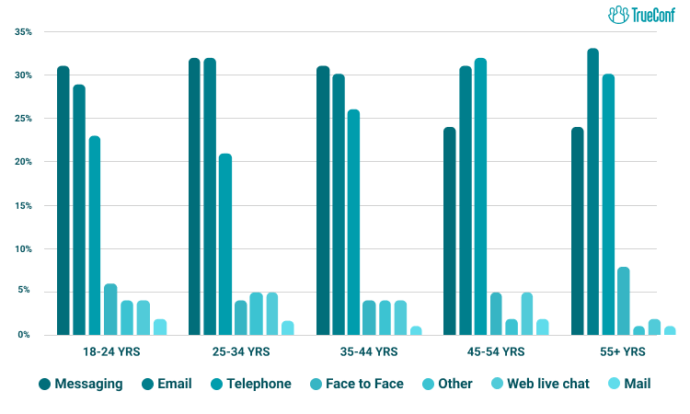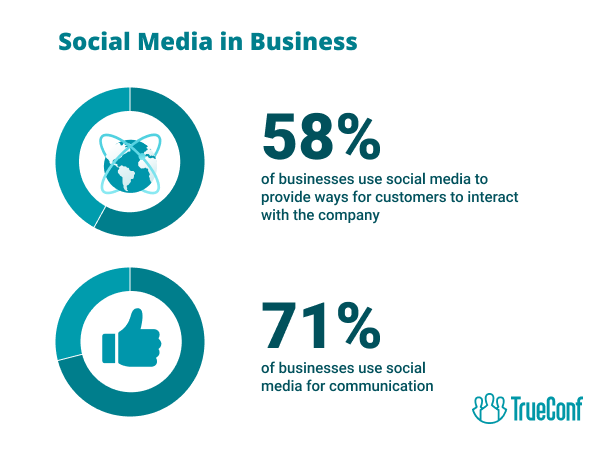Digital Communication: Channels & Guidelines
What is Digital Communication?
Digital communication involves transmitting information electronically through various devices utilizing the Internet. Unlike analog communication, which relies on continuous signals, digital communication divides data into distinct segments for transmission, enhancing speed and reliability. Additionally, digital communication facilitates seamless integration of multimedia elements, enriching information exchanges with greater dynamism.
Externally, digital communication serves as an essential tool for businesses to establish connections with customers, suppliers, and partners on a global scale. Various platforms provide a process flow slide for businesses with multiple avenues to engage with their audience, collect feedback, and foster brand loyalty.
According to Statista, the global number of active social media users exceeds 4.2 billion, highlighting the crucial role of social media in facilitating businesses’ connections with their target demographic.
Key Elements of Digital Communication
- Sender. The sender initiates the message. It may be an individual, a device, or a system that generates the information for transmission.
- Encoder. The encoder converts the sender’s message into a digital format suitable for transmission through a communication channel. This process involves transforming the information into binary code, composed of 0s and 1s, which digital systems can interpret.
- Channel. The channel acts as the route for the encoded message to move from the sender to the receiver. In digital communication, channels may be wired, such as Ethernet cables, or wireless, like Wi-Fi and cellular networks.
- Decoder. The decoder is essential for converting the received digital signal into a format comprehensible to the receiver. This involves reversing the encoding process by converting binary code into text, audio, video, or other data formats.
- Receiver. The receiver marks the conclusion of the communication process, accountable for obtaining and deciphering the message. It might be an individual, a device, or a system capable of comprehending and utilizing the information.
Take your team communication to the next level with TrueConf!
A powerful self-hosted video conferencing solution for up to 1,000 users, available on desktop, mobile, and room systems.
Benefits of Digital Communication
- Convenience: Information disperses rapidly on a global scale, enabling smooth connections across geographical boundaries. This seamless flow of information is a crucial piece of the digital transformation puzzle, allowing businesses to operate more efficiently and reach a wider audience.
- Cost-effectiveness: Minimizes the requirement for face-to-face meetings and travel, resulting in both time and financial savings.
- Improved Efficiency: Simplifies work processes using tools such as email, project management systems, and instant messaging, thereby boosting overall productivity.
- Storage and Management: Digital data can be effortlessly stored, searched, and retrieved, ensuring a dependable record of communications.
- Collaboration Enhancement: Facilitates immediate collaboration with the customers, vendors, and team members you have collected in your digital address book either through video conferencing, shared files, and online platforms. It fosters teamwork and innovation in the long run.

Face-to-Face Communication vs. Digital Communication
Although digital platforms provide convenience and connectivity, face-to-face interactions are essential due to their depth and authenticity. Analyzing both communication methods using statistical data and real-life examples—such as a violin plot to visually represent message frequency or engagement across channels—helps comprehend their distinct advantages and limitations.
Face-to-face communication includes verbal and non-verbal cues like body language, eye contact, and tone of voice, which significantly contribute to understanding and empathy. An effective attendance system can complement such interactions by ensuring team members are present and engaged during crucial in-person meetings.
An investigation by Forbes in 2017 discovered that 84% of individuals prefer in-person meetings for cultivating stronger, more meaningful relationships.
Digital communication, encompassing emails, social media, and video conferencing, has transformed the way we interact by offering unparalleled convenience and connectivity. Numerous businesses are presently embracing a hybrid approach, blending face-to-face and digital communication to optimize the advantages of both. They commence with in-person meetings to establish rapport, followed by digital platforms for ongoing collaboration. In such hybrid settings, tools like Betterpic, a customizable AI headshot generator, can help maintain a consistent and professional presence across digital communication channels.
Types of Digital Communication Channels
Email provides a flexible platform for immediate messaging that transcends geographical limitations, streamlining project management and facilitating task distribution. When sending cold emails, maintaining a clean email list through email verification is crucial.
Additionally, leveraging tools like ChatGPT, combined with an AI bypasser, can be instrumental in creating engaging emails tailored to your audience. These tools help generate compelling content while adjusting the tone to suit your readers, fostering a deeper connection and enhancing engagement, ultimately driving better responses from your email campaigns. You can also use an email subject line generator to create variations and select the most suitable one based on the email context.
Instant Messaging
Instant messaging has altered our methods of communication in both personal and professional contexts, enabling us to bridge distances and share information rapidly. Leading businesses often partner with a development company to create custom messaging and collaboration platforms. Whether used for informal chats or professional partnerships, instant messaging provides unparalleled speed and convenience.
Social Media
As of 2021, around 4.48 billion individuals globally utilized social media, constituting more than 57% of the world’s population.
Social media platforms facilitate businesses in engaging with their desired demographics, launching marketing initiatives, and deriving valuable insights through data analytics. For instance, using TikTok emojis creatively in posts can increase engagement by conveying tone, emotion, and branding more effectively, especially among younger audiences accustomed to visual language.

Digital communication has revolutionized how professionals connect and interact, with platforms like LinkedIn serving as pivotal hubs for networking and information exchange. Additionally, for those seeking discreet browsing options, an anon IG viewer can help explore Instagram profiles without revealing user identity.
Video Conferencing
Video conferencing plays a crucial role in supporting remote work by seamlessly integrating audio, video, and collaborative tools. Recent data emphasizes their considerable influence, pointing to a notable rise in usage.
During the COVID-19 pandemic in 2020, the global market for video conferencing reached $5.77 billion. Forecasts predict that by 2027, it will expand to $10.92 billion, with a compound annual growth rate (CAGR) of 9.9%.
In addition to video conferencing, co-browsing solutions and GMB posting software offer powerful ways to enhance remote collaboration and maintain consistent local business presence across digital touchpoints. These tools allow participants to interact with the same web content in real-time, improving problem-solving and support during virtual meetings.
Kudremukh Iron Ore Limited (KIOCL)|Case Study
KIOCL provided their employees with secure tools for collaboration, video calls, and team messaging by implementing TrueConf Server. An autonomous system unified more than 1,000 employees allowing to facilitate work meetings in hybrid and online modes from any location.

Surveys
Surveys play a vital role in the digital realm for collecting feedback, assessing customer satisfaction, and understanding market trends. Conduct surveys using tools like NPS survey software to engage with your audience, refine strategies, improve products and services, and foster brand loyalty. Moreover, in the current data-centric landscape, surveys aid in making well-informed decisions, assisting businesses in remaining competitive by responding to evolving consumer demands.
SMS
SMS marketing initiatives offer a rapid and economical means to engage with a broad audience, whereas SMS notifications can be a crucial part of an ecommerce conversion funnel and serve to update customers regarding appointments, deliveries, and promotional offers. In times of crisis, SMS serves as a vital channel for governments, public safety entities, and organizations to distribute urgent alerts and critical information amid natural disasters, public health emergencies, or other pressing circumstances.
Blogs
Blogs are a dynamic communication channel used to educate, engage, and build trust with audiences. Businesses use blogs to share updates, showcase expertise, explain products or services, and improve SEO rankings by targeting specific keywords. When combined with effective SEO services, blogging becomes an even more powerful strategy for increasing online visibility, attracting qualified leads, and outperforming competitors in search engine results.
Global SEO companies perform blogs with tools like AI-powered writing assistants and content planning platforms, it’s easier than ever to maintain a consistent publishing schedule and produce high-quality articles. Readers value blogs that offer insights, how-tos, industry trends, and authentic storytelling. In addition, comment sections allow for two-way communication, turning static content into interactive discussions and fostering deeper community connections. To support this content strategy, businesses often invest in robust cloud content management systems and web infrastructure.
Digital Communication Guidelines
Developing precise protocols like SPF, DKIM and DMARC for digital communication within the workplace is essential to promote productivity, collaboration, and a harmonious work atmosphere. Below are several fundamental principles to contemplate while formulating these guidelines:
- Purpose and Context: Determine which tools are best used for urgent tasks and which are better suited to support the overall workflow.
- Clarity and Conciseness: Encourage employees to communicate clearly and concisely, being mindful of the recipient’s time and attention. Consider working with software development companies to help you create software for internal corporate communications as it will not only boost employee productivity but also impact the overall morale.
- Timeliness and Responsiveness: Set expectations for timely responses to digital communications based on the urgency and importance of the message. Make sure your team has a clear crisis communication plan to handle urgent situations and keep messaging consistent.
- Privacy and Security: Educate employees about the importance of safeguarding sensitive information and respecting the privacy of colleagues when communicating digitally. Remind them to use secure channels for sharing confidential or proprietary information and to avoid discussing sensitive topics in public forums.
- Etiquette for Virtual Meetings: Provide guidelines for conducting virtual meetings, including muting microphones when not speaking, and using features like chat and hand-raising respectfully.
- Managing Digital Overload: Encourage employees to be mindful of digital overload and to establish boundaries for when they will be available and responsive to digital communications outside of regular working hours, using listening tools social media to track relevant communications while minimizing distractions.
- Feedback and Continuous Improvement: Regularly solicit feedback from employees about the effectiveness of the digital communication guidelines and be open to making adjustments as needed.
Digital Communication and Data Transformation
Digital communication plays a pivotal role in data transformation by enabling the seamless exchange of information across platforms. By integrating this communication with effective data management strategies, businesses can optimize workflows, foster innovation, and stay competitive in an increasingly digital world.
Conclusion
Digital communication plays a crucial role in modern businesses, enhancing efficiency, fostering innovation, and facilitating growth. As companies undergo digital transformation, the integration of digital communication tools becomes essential to maintain competitiveness. AI-powered chatbots streamline customer support services, VR and AR technologies revolutionize product demonstrations and virtual meetings, while improvements in internet infrastructure ensure seamless connectivity and data transmission.
FAQ
Why is choosing the right communication channel important?
The effectiveness of digital communication depends on aligning the channel with the message. For example, detailed reports may be best delivered through email, while quick updates suit chat apps. Leveraging data analytics can help organizations understand which channels drive better engagement and responsiveness.
How does design affect digital communication?
Visual presentation plays a critical role. Using friendly fonts in internal newsletters or external campaigns makes messages easier to read and more approachable. Likewise, brand-consistent design elements ensure clarity and recognition across different communication platforms.
What role do creative tools play in enhancing digital communication?
Creative tools improve how ideas are shared and understood. For example, Picsart’s color picker helps teams maintain consistent branding by matching precise colors in presentations, social media graphics, or email campaigns, which strengthens brand identity and professionalism.
Can digital communication integrate with broader business strategies?
Absolutely. For instance, companies investing in a WordPress development service can seamlessly embed communication tools such as chat widgets, blogs, or customer portals within their websites. This integration streamlines interaction with audiences and makes communication more effective.
About the Author
Nikita Dymenko is a technology writer and business development professional with more than six years of experience in the unified communications industry. Drawing on his background in product management, strategic growth, and business development at TrueConf, Nikita creates insightful articles and reviews about video conferencing platforms, collaboration tools, and enterprise messaging solutions.



Follow us on social networks